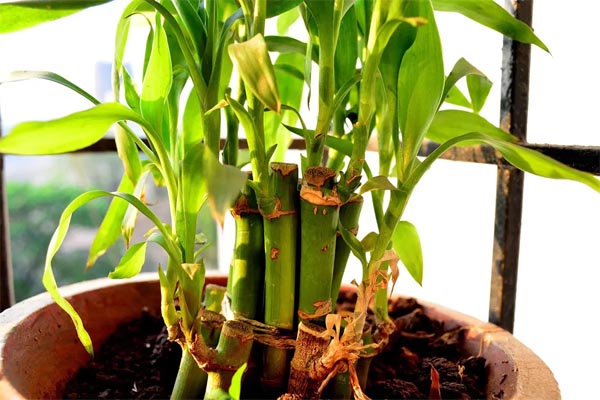
Tips to Keep Your Lucky Bamboo Plant Thick and Lush
Lucky Bamboo, known for its aesthetic appeal and cultural significance, is a popular indoor plant believed to bring good fortune and positive energy. While these elegant plants are generally easy to care for, maintaining their thick and lush appearance requires attention and know-how. In this guide, we’ll explore practical tips to ensure your Lucky Bamboo thrives and remains a symbol of prosperity in your space.
Tips to Keep Your Lucky Bamboo Plant Thick and Lush
- Choose the Right Pot and Soil
- Proper Watering Technique
- Lighting Conditions
- Regularly Rotate Your Plant
- Maintain the Right Temperature
- Fertilize Wisely
- Prune with Care
- Regularly Clean the Leaves
Choose the Right Pot and Soil
Start with a well-suited pot and soil. Ensure the pot has drainage holes to prevent waterlogging and use a well-draining, rich potting mix to provide essential nutrients for your Lucky Bamboo’s growth.
Also Read This : A Guide to Budget-Friendly Garden Renovation Ideas
Proper Watering Technique
Lucky Bamboo prefers to be consistently moist but not soggy. Water the plant sparingly, allowing the top inch of the soil to dry between waterings. Use distilled or filtered water to avoid the buildup of harmful minerals from tap water.
Lighting Conditions
Lucky Bamboo is adaptable to various light conditions but thrives in indirect light. Avoid direct sunlight, as it can scorch the leaves. If the plant appears leggy or thin, consider adjusting its exposure to light to encourage more compact and thick growth.
Also Read This : Transforming Yellow Money Plant Leaves to Vibrant Green
Regularly Rotate Your Plant
Rotate your Lucky Bamboo every few weeks to ensure all sides receive equal sunlight. This helps prevent lopsided growth and encourages the plant to develop evenly, contributing to a fuller appearance.
Maintain the Right Temperature
Lucky Bamboo prefers temperatures between 65°F to 90°F (18°C to 32°C). Avoid exposing it to cold drafts or extreme temperatures, as this can stunt growth and lead to thinning of the stems.
Also Read This : Sunflower Seeds: Small but Mighty! Unveiling Health Benefits You Need to Know
Fertilize Wisely
Use a balanced liquid fertilizer diluted to half-strength during the growing season (spring and summer). Apply fertilizer every 4-6 weeks to provide essential nutrients without overfeeding, which can lead to weakened growth.
Prune with Care
If you notice any yellowing or weak stems, prune them with clean, sharp scissors or pruning shears. Trimming back unhealthy or overgrown parts encourages new growth and helps maintain the plant’s overall thickness.
Also Read This : Best Indoor Plants That Grow Well Under Artificial Light
Regularly Clean the Leaves
Dust can accumulate on the leaves, hindering the plant’s ability to absorb light. Gently wipe the leaves with a soft, damp cloth to keep them clean and dust-free, allowing optimal photosynthesis.
Also Read This : 10 Benefits of Tulsi You Should Know
Addressing Yellowing Leaves: A Guide for Lucky Bamboo Care
Yellowing leaves in your lucky bamboo plant often indicate excessive light exposure or over-fertilization, leading to an unhealthy appearance. To remedy this, consider the following steps:

What to do when leaves turn yellow
- Adjust Lighting Conditions
- Reposition Away from Direct Sunlight
- Reduce Fertilizer Application
- Monitor Fertilizer Frequency
- Flush the Soil
- Evaluate Overall Plant Health
Adjust Lighting Conditions
If you observe yellowing leaves, your plant is likely getting too much light. Shift your lucky Bamboo to a location with reduced light exposure, avoiding direct sunlight. Ensure the plant is shielded from excessive brightness to promote optimal health.
Also Read This : Mastering the Art of Replanting Aloe Vera with Roots
Reposition Away from Direct Sunlight
Protect your plant from direct sunlight, which can contribute to leaf discolouration. Move it to a spot where it receives filtered or indirect light, preventing harsh rays from causing damage.
Reduce Fertilizer Application
Lucky bamboo plants are not heavy feeders and can thrive with minimal fertilizer. Excessive fertilization can lead to yellowing leaves. Scale back on fertilizer application, allowing the plant to recover and regain its healthy appearance.
Also Read This : Swaying Beauties: Plants That Cannot Grow Without Support
Monitor Fertilizer Frequency
Lucky bamboo plants can withstand periods without fertilization. If you’ve regularly fertilized your plant, consider giving it a break and only reintroducing fertilizer when necessary. This helps prevent adverse reactions and ensures the plant receives nutrients without overloading.
Also Read This : Balancing Act: Determining the Right Amount of Compost for Your Plants
Flush the Soil
If you suspect fertilizer buildup, consider flushing the soil with plain water. This helps remove excess salts and nutrients that may contribute to the yellowing of the leaves. Allow the water to drain thoroughly to prevent waterlogging.
Also Read This : Signs Your Compost is Ready to Transform Your Garden
Evaluate Overall Plant Health
Assess the overall health of your lucky Bamboo. Trim any yellow or damaged leaves with clean, sharp scissors or pruning shears. This promotes new growth and maintains the vitality of the plant.
Also Read This : 10 Low-Maintenance Balcony Plants to Transform Your Outdoor Oasis
Caring for your Lucky Bamboo is a rewarding experience, and with these tips, you can ensure that it remains a vibrant and thick symbol of good fortune in your home or office. Remember to observe your plant regularly, adjust care practices as needed, and enjoy the beauty and positive energy it brings to your space.




